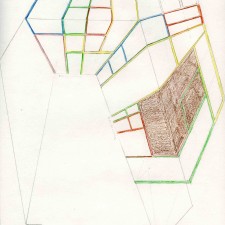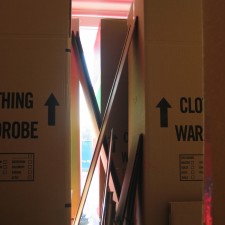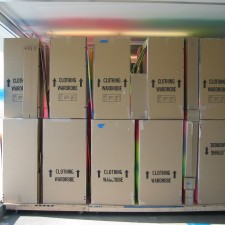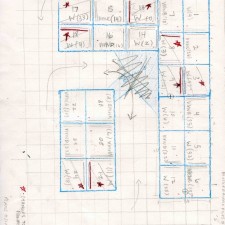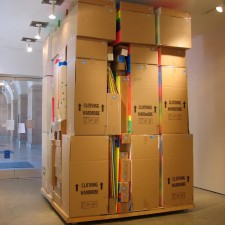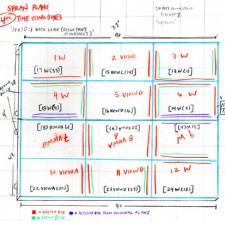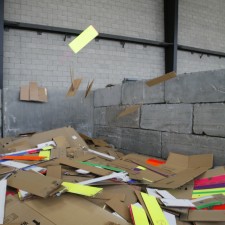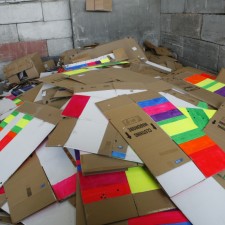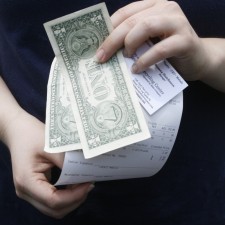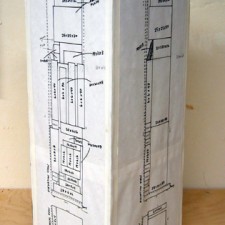BOX PROJECT // 2003-07

BOX PROJECT: reluctant monument recycled, 2007
Reluctant Monument Recycled is a series of photographs which are the final phase of Ziperstein’s Box Project.
Photo documentation by Craig Havens.
BOX PROJECT: 10 x 10: 8 Week Lease (Reluctant Monument) | 5th Incarnation | 2003 – 05
Cardboard boxes, neon paint, tape, velcro & custom plywood dollies
11 h x 10 w x 10′ d
San Francisco Arts Commission Gallery, San Francisco, CA
BOX PROJECT: 10 x 5: 5 Week Lease (Sandwich) | 4th Incarnation | 2003-05
Cardboard boxes, neon paint, aqua foam pallets & neon pink mason twine
8 h x 5 w x 10’d
Exhibition at Bank, Los Angeles, 2005
BOX PROJECT: 4 x 9: 1 Day Lease | 3rd Incarnation | 2003 – 04
Cardboard boxes, neon paint & custom plywood dolly
5 h x 4 w x 9′ d
Supersonic Exhibition, 2004 Art Center College of Design, South Campus Wind Tunnel, Pasadena, CA.
BOX PROJECT: 10 x 20: 11 Week Lease | 2nd Incarnation | 2003 – 04
Cardboard boxes, neon paint, tape, velcro & custom plywood dollies
9 h x 20 w x 10′ d
Supersonic Exhibition, 2004
Art Center College of Design, South Campus Wind Tunnel, Pasadena, CA.
BOX PROJECT: 10 x 20: 1 Week Deposit | 1st Incarnation | 2003 – 04
MFA Thesis Exhibition, 2004
Cardboard boxes, neon paint, neon tape & custom plywood dollies
9 h x 20 w x 30′ d
MFA Thesis Exhibition, 2004
California Institute of the Arts, Gallery A402, Valencia, CA.
BOX PROJECT: schematics, 2003-07
ESSAY
Wheelock, Bill. “The Serial Box Attitude,” artist book, June 2005, ed. 325
In On Beyond Zebra, Dr. Seuss tells the story of child who, having mastered all twenty-six letters in the alphabet, claims to command all that can be known. Similarly in an old Monty Python skit, a Shakespearian actor comments on the difficulty of playing the part of King Lear, who not only has to learn 7,054 words, but also laments, “getting them in the right order is just as important.” Bari Ziperstein’s sculpture handles the heady topic of recombinance with just such a light touch.
Ziperstein’s boxes create a language out of serial arrangements of modular elements which absorb meaning with every actual or designed configuration. Cardboard storage boxes of varying standard sizes, some bearing panels striped with bright fluorescent paint, are folded, expanded, and stored; or carefully rearranged to fit truck, palate, or wall; at times even aspiring to ephemeral architecture. These elements comprise a vocabulary organized into deliberate patterns and sequences to subtly reflect and influence other nearby units within each series. In Ziperstein’s art, recombinant forms structured by means of code manifest into expression just as DNA sequencing patterns the configuration and attitude of life.
These sequences form patterns which, when repeated, construe a set of rules, complete with exceptions to be made or broken by the artist. The footprints of each configuration always match standard self-storage container dimensions. The same boxes are re-used from exhibition to exhibition, accumulating marks just as a postal package might during circulation. Within the interstices of the box structures, painted panels are almost always stacked so that the fluorescent faces oppose panels which have been painted white, optimizing the reflection of light and color. These piles of pulp are designed, therefore, by the collision of an almost obsessive planning with unavoidable happenstance; both nurture and nature.
In the digital age when almost all cultural information can be conveyed with the one and the zero, the recognition, reception, and adoption of novel combinations becomes dependent, more than ever, on packaging. Packaging engages story and myth activating these relational elements which would otherwise be as lifeless and static as the periodic table, or an alphanumeric code. Narration is associative, extracting meaning through sequence and proximity to memory. In Ziperstein’s sculpture, Geometric bands of fluorescent color striate across earth toned brown cardboard recalling the retinal assault of strolling through the cereal or detergent aisle in a supermarket. But packaging, especially in the case of the cultural media is not only limited to the visible surface; packaging has become conceptual and embedded, the raison d’ être of much cultural produce. Ziperstein renders the material remains: the detritus of storage, the archives of material hardcopy, ripe with the decaying scent of its fugitive matter.
This reconfiguration of modular elements has long been a subject in minimal and post minimal art, particularly in Mel Bochner’s 36 Photographs and 12 Diagrams (1966) made prior to writing the 1967 essay “The Serial Attitude.” LA MOCA’s 2004, “A Minimal Future?” displayed Mel Bochner’s collection of seemingly identical one-inch wooden cubes, apparently the “original models” for the pictures that depict the blocks reconfigured into various symmetrical patterns. These cubes, whether authentic or no, were presented as if they had accumulated some type of value through being photographed-quite the inverse to the Native American fear that photography might rob subjects of their soul. In an operation familiar to consumers of American pop-culture, the magical transference media performs actually invests its subjects (however banal) with soul.
What makes one want to strive for a relationship, for some distinction of individuality with these almost identical units? Can Bochner even tell them apart? Ziperstein’s 847 boxes are each inventoried bearing notes and labels as testament to their past configurations. Bochner’s cubes (particularly in the context of MOCA) conjured the austerity of the minimalist and Bauhaus aesthetic along with some of its utopianism, whereas beholding Ziperstein’s stacks of cardboard brings to mind more dread-filled business: the backsides of retail, contemplating the next moving day, and the entropy of storage as a consequence of overconsumption. These may, regrettably, be the urgent design problems facing our decidedly less utopian contemporary lifestyle. Ziperstein’s sculpture and working drawings combat this chaos with a gloriously absurd and rigorous inventory codex (perhaps only fully comprehensible by the artist) tempered, gracefully, by a lightness and humor worthy of Seuss and Python.






